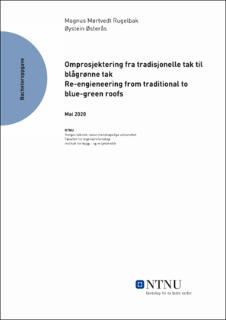| dc.description.abstract | Byer vokser i dag stadig, og urbaniseringen i Norge er et faktum. Klimaendringer skaper også mer ekstremvær her i landet, og man opplever flere flommer og mer intens nedbør. Urbaniseringen medfører økt anleggelse av flere tette flater som gir større påkjenning på overvannsnettet og skaper problemer med oversvømmelse i byene. Blågrønne tiltak i byer er blitt mer og mer populært, og vil bli en viktig del av ny utbygging fremover. Blågrønne tak er ett av disse tiltakene som hjelper til med å fordrøye vann. Tradisjonelt sett er blågrønne tak mest aktuelle på store flate tak som skoler, kontorbygg og andre større bygg. Men i byer der det bygges tett, blir det mer og mer aktuelt å legge blågrønne tak på boliger med mindre takareal.
I denne oppgaven ønsker vi å se på omprosjekteringen fra tradisjonelle tak til blågrønne tak. Målet er å komme med en løsning til et blågrønt tak på Norgeshus sitt modellhus, Dråpen Moderne. Oppgaven tar for seg teorien rundt blågrønne tak, både når det gjelder avrenningen og den fordrøyende effekten av taket, konstruksjonsprinsippene og oppbyggingen av blågrønne tak. I resultatdelen av oppgaven vil konkrete forslag til oppbygging av taket presenteres, og det vil bli sett på forskjellen i økonomi og tidsforbruk sammenlignet med tradisjonelt tak. Avrenningen og effekten av løsningen vil også beregnes og presenteres sammenlignet med et tradisjonelt tak.
Oppgavens hovedfokus og problemstilling tar for seg oppbyggingen og effekten av taket, og omfatter derfor ikke alle aspekter ved blågrønne tak. Det vil kreves en mer omfattende prosjektering ved etablering av et blågrønt tak enn hva denne oppgaven tar for seg. Brannaspekter må prosjekteres mer grundig, da punktene som blir sett på rundt brannprosjektering i oppgaven er for å kunne tegne detaljer av taket. Legging av blågrønt tak fører til økt vekt og belastning på konstruksjonen. Dimensjonering av bæresystemet er også noe som må gjennomføres, men dette inngår ikke i denne oppgaven. | |
| dc.description.abstract | Climate changes create more extreme weather, and with that weather comes more intense rainfall. Regulations regarding the allowed discharge of rainfall on to public drainage systems set to handle stormwater in the municipalities have been getting stricter over the last years and will probably continue to do so. To combat these changes blue-green stormwater solutions have become increasingly more common. One of these solutions is blue-green roofs. This bachelor thesis addresses the reconstruction on Norgeshus’s catalog house Dråpen Moderne from a traditional roof to a blue-green roof. Traditionally blue-green roofs are often used on larger buildings like schools and offices, and not on residentials. This bachelor thesis will look at different aspects of blue-green roofs and whether it is viable to have blue-green roofs on residential or not. Challenges concerning fire hazards are lightly touched upon but would need a more comprehensive review, which is not a part of this thesis. The thesis does not discuss problems regarding the additional weight that comes with blue-green roofs.
The thesis will first look at the theory behind blue-green roofs, including the principles of construction, how blue-green roofs are layered, and the function of each layer. The theory on how the amount of stormwater runoff is calculated is also something that is included, and specifically how the runoff is regarding blue-green roofs. The theory part of the thesis also includes an overview of the regulations and demands concerning stormwater runoff in some of Norway’s biggest municipalities.
The thesis will then include a recommended solution for Dråpen Moderne, on how the roof should be constructed. The contribution regarding runoff specifically for Dråpen Moderne is discussed. It is also looked at the difference in the runoff from a housing estate, where all the roofs are changed to blue-green roofs and the effect of this. Another aspect looked at is the economy and time spent during the construction of blue-green roofs compared to traditional roofs.
It is clear that blue-green roofs do have an effect in reducing the runoff from roofs. With the blue-green solution made to Dråpen Moderne, you can use 0,5 as a runoff-coefficient, instead of 0,9, which is recommended for traditional roofs. The effect of this is clear and an example where all the roofs in a housing estate were changed to blue-green roofs, the runoff from the entire area was reduced by 15,6%. Blue-green roofs are often not enough alone, but it does have a substantial contribution.
In choosing a blue-green roof over a traditional roof there will be added costs to it. The material used in a blue-green roof costs more, as well as the cost of labor for the added time it takes. In total, the added cost to the specific house in this thesis for going with a blue-green roof is 1,8 %.
As a conclusion it shows that blue-green roofs on residentials could have a clear impact on reducing stormwater runoff. But the added cost of having a blue-green roof might not make it worth it everywhere. In cities where there are a lot of buildings and roads close to each other, blue-green roofs do have a justified place to be. But in more rural environments where stormwater runoff is not a big problem, the effect of the blue-green roof would become less important and it would not be a viable solution considering the added cost, unless you value the esthetics of it. | |
